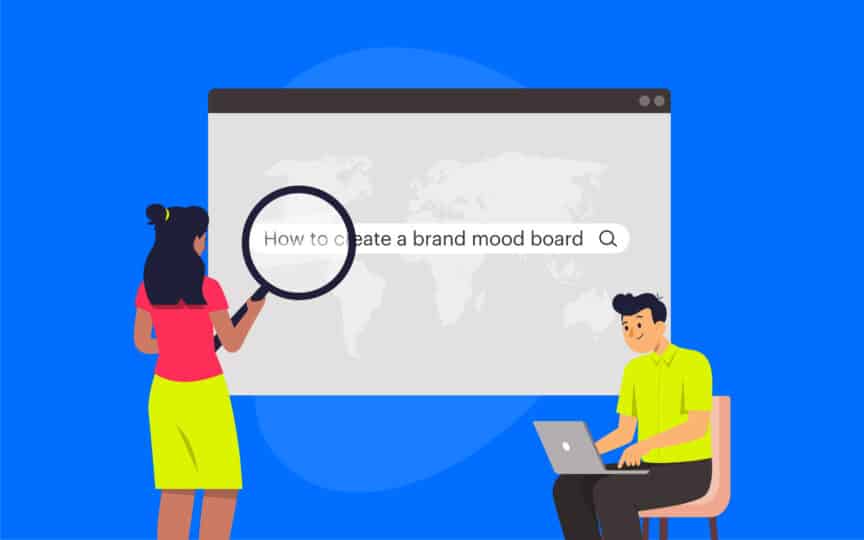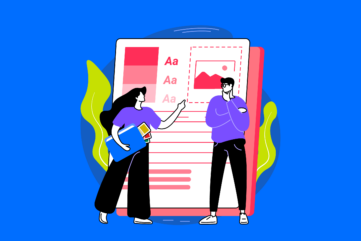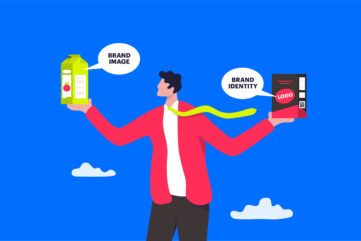How to make a brand mood board to inspire (with examples)

Creating your own brand mood board is more useful than you’d think. After all, it’s easy to underestimate the amount of work that goes into building a brand, even when you’re just focusing on the “visual” aspect of your brand identity.
It’s not just your logo design that determines whether you can connect emotionally with your target audience. Seemingly small things, like your chosen color palette, fonts, and even the shapes you use can make a huge difference to your overall impact.
Creating a branding mood board is a great way to organize all of your ideas and thoughts into a single visual tool that can guide you, your team, and even the creative experts you work with.
You can even create mood boards for a range of different purposes. On top of your “brand identity” mood board, you might design mood boards for marketing campaigns, product launches, and more.
Today, we’re going to tell you not just how to create a brand mood board, but why you should, and how you can ensure it’s a success. Plus, we’ll be sharing some great brand mood board examples to inspire the creation of your own template.

What is a brand mood board? The branding mood board
As branding specialists, we use a lot of different tools to help define, and develop brands. Mood boards are one of our favorite resources. They’re essentially a visual starting point for your branding strategy, combining all of the visual assets you need for inspiration into one place.
A branding mood board is a curated collection of all the inspiration, colors, images, text, photos, and anything else that might help drive your creative process. Even before the rise of digital mood board tools like Pinterest, artists have used these tools for decades.
In many creative landscapes, people still use physical collages as a valuable resource to help guide a design project, or move a campaign in the right direction.
As mentioned above, a mood board template can be used in a variety of different ways. If you’re launching a brand for the first time, a mood board can be a great way to convey the “feeling of your brand” in a visual format to shareholders and creative team members.
If you’re building a new product, you can use your mood board as a visual reference to help you make decisions that align with your existing brand guidelines.
Your brand mood boards can help to ensure everyone is on the same page when working on a creative project, aligning all of the tools you need in a cohesive way, to ensure consistency.

Why build a brand identity mood board?
Often when companies and entrepreneurs are keen to launch a brand or a new product, they avoid taking extra steps during the “planning” phase. Designing digital and physical mood boards can seem like a daunting and time-consuming process.
However, these resources are one of the best ways to ensure any project is a success. Your “inspiration board” can help you clarify the visual style of your brand before you start producing marketing campaigns, or selling new products.
They can act as valuable design inspiration for everything from website design to product development strategies.
Primarily, branding mood boards:
- Act as a source of inspiration: It’s easy to get stuck for ideas during the branding process. A mood board can give you the consistent inspiration you need to preserve your creative spark.
- Ensure cohesion: Similar to a brand style guide, effective mood boards can help to align your team and contractors around a cohesive brand identity, improving consistency.
- Accelerate projects: A brand mood board can act as a compass to guide the decisions you make during creative projects. This means you can complete your projects much faster.
- Answer questions: Exploring your mood board options will help you answer questions about everything from the colors that make the biggest impact, to the fonts you should use.
- Support teams: A brand mood board can be a valuable tool for your graphic designer, logo designer, or creative team. They give them a “launching point” for a project.

What to include in your brand mood board template
We’ll cover some examples of brand mood boards in a moment. However, first, it’s worth establishing what kind of content your mood board should include.
Though there’s no one-size-fits-all strategy here, there are some key elements you need to consider:
Colors
The colors you use in your branding assets are some of the most important resources you have. Colors aren’t just visually impactful; they have an emotional influence too. Color psychology influences how we think and feel about companies, and the products they sell.
Think about the colors that typically resonate with customers in the industry you want to serve, and look at your competition for inspiration. Think about your brand’s identity, and what you can tell your potential clients with the colors you choose.
For instance, if you want to create a “laid back” vibe, you might use blues and greens. If you’re building a brand that you want to seem fun and youthful, you might choose brighter colors like yellow and orange.
Include swatches and hex codes in your mood board.
Shapes
You may already know that colors have an emotional impact – but what about shapes? Shapes are evocative too, particularly when combined with different colors. They can act as visual metaphors to tell your customers more about your brand and products.
For instance, we often associate circles with ideas like unity and inclusion, while arrows point to a brighter future. Squares and rectangles are seen as strong and robust, while triangles are more aggressive, and modern.
Think about how shapes will work together on your packaging, your logos, website design, and everything else you create.
Photos and images
The phrase “a picture is worth a thousand words” certainly rings true in branding. Photographs, illustrations, and other types of pictures can make a huge impact on your audience. Search for inspirational images that align with your overall brand identity.
If you’re launching a new product, you might combine photos you already have of your item with pictures you like created by competing businesses.
If you’re creating a marketing campaign, you might look for specific photos that help to convey your brand’s personality and core values. For instance, if you want to be seen as a customer-centric brand, pictures of smiling customers can make a huge difference.
Textures and patterns
Textures and patterns also add visual interest to your brand mood board, and the assets you create. If you’re creating a campaign promoting new lingerie, you might use lingerie. If you’re trying to create a boho vibe, you might experiment with macrame.
Textures can even appear in website and graphic design, so don’t be afraid to experiment with different styles that make parts of your page leap out to your audience.
Patterns, like polka dots, stripes, and zig-zag designs can also help speak to who you are as a brand, and draw the attention of your ideal client.
Text and fonts
While branding mood boards typically tell a visual story, that doesn’t mean there’s no place for text. Including segments of text, such as your brand slogan, or a small paragraph of information about your brand’s identity, or your product can be extremely helpful.
Text can help to give context to a collection of images, and remind people of the brand personality you’re trying to convey.
Including text on your mood board is also a good way to showcase the kinds of font and typography you want to use. Remember, font can also have an emotional impact on your audience. Rounded, sans-serif fonts are more modern, while serif fonts appear authoritative and professional.
Any other sources of inspiration
On top of all that, you can also include anything else you consider “inspiring” to your brand mood board. This could include snippets of marketing campaigns from the companies you aspire to replicate, which are great as reference points for your designers.
You might include images you want to avoid, or colors that don’t work with your business. You can even include inspirational images that you think connect well with your core values, and the overall message you’re trying to send to your audience.
Get creative with newspaper and magazine clippings, and even videos if you’re using a digital mood board.

How to create a brand mood board
We’ve covered what a brand mood board is, why it’s important, and what it should include, now it’s time to get to the fun stuff, creating your own beautiful mood boards. The good news? It’s often easier than you’d think, particularly if you have the help of a branding expert.
Here’s your step-by-step guide to getting started.
Step 1: Define your audience
The first step in building an effective mood board is identifying your audience. Notably, there may be multiple different audiences to think about here. First, you’ll need to consider the target audience of your company, and the people you want to connect with on an emotional level.
If you don’t already have customer personas, now is the time to make them. Think about the demographic, psychographic, and behavioral characteristics of your ideal clients. Consider what kinds of shapes, colors, and images will resonate with them.
Next, think about who you’re going to be sharing your mood boards with. What kind of visual medium do they work best with? What sort of information will help them to create the asset or marketing campaign you’re going to be building?
Step 2: Do your research
When you’re building your own mood board, inspiration is key. You can start by taking a closer look at your existing brand assets. Think about your values, your mission, and the visual elements you’ve used to convey these concepts to audiences in the past.
If you’re creating a mood board to develop your brand image, or you don’t have any existing assets, conduct research into your competition. Find out what kind of colors and components they use to resonate with a similar audience.
Check out influencers across social media, and use Pinterest to get insights into how mood boards are often constructed. Remember, your brand mood board should convey the overall identity and ethos of your brand, so make notes about what you want to accomplish with your brand as you go.
Step 3: Brainstorm
Using the inspiration you’ve collected as guidance, it’s time to start brainstorming. Often, it’s helpful to get multiple members of your team involved in this process. Collecting insights and different perspectives can help you design a more cohesive, powerful mood board.
Small business owners and evolving brands might also consider working with graphic designers or branding consultants to help them during this stage.
Make a list of all the things your mood board should include. You can use our list of items to include in your brand mood board template to help you here. Then start sourcing images, colors, fonts, and other elements that make sense for your project.
Step 4: Assemble your mood board
How you actually choose to assemble your mood board will vary depending on your resources, and preferences. You might decide to take a physical approach, with cutouts and physical materials. However, we often find it’s easier to create digital collages.
There are plenty of tools like Canva and PowerPoint that can help you align all of your mood board elements in one cohesive place. Plus, these tools often allow users to collaborate, so you can ask your team members to share their insights too.
Don’t be afraid to make your brand mood board your own, adding borders and other unique elements to make it stand out. Just ensure the extra visuals you add don’t draw attention away from the key design elements you want to share with your team.
Step 5: Refining your vision
Once you have all your visual elements assembled onto a mood board, it’s worth taking some extra time to fine-tune everything. If necessary, take a step back from your project and give yourself a break from looking at all of the different materials together.
Ask your colleagues to step in and offer their own insights. This can be a good way to ensure that you’re creating a cohesive branding mood board that includes all of the right information.
Remove anything that dilutes your design ideas or doesn’t deliver value to the project. Once you have your “final mood board”, start sharing it with the stakeholders in your project. Just be ready to make changes and updates if you discover something is missing.
Brand mood board examples to learn from
A brand mood board can be an amazing resource for businesses, marketers, and designers alike. It can help keep everyone aligned around color schemes and design choices. Plus, it’s a great source of consistent inspiration.
However, if you’re not an expert in design yourself, creating a mood board can seem like a daunting project. Sometimes, it helps to get a little inspiration from the experts.
Here are some great brand mood board examples to guide you.

1. No Sugar Coca-Cola
Designed to guide marketing campaigns, the No Sugar Coca-Cola mood board created by Ivan Zimmerman is a great insight into how simple an effective mood board can be.
This single-page branding asset isn’t overwhelmed with information, but it includes all of the details a designer might need, from font and statements, to color palettes, photography, and shapes. It also aligns perfectly with the wider Coca-Cola brand.

2. Minimalist mood board
This minimalist mood board from Chris Plosaj is packed with useful information. It includes text and slogans, as well as font choices (and sizes for different headers). The board showcases brand colors, insights into buttons and CTA sections for a website and more.
If you’re creating a mood board to guide your website design strategies, following a similar strategy can give your designer an excellent starting point.

3. Beer branding mood board
This is another example of a relatively straightforward mood board that still conveys plenty of information. Images of people in an outdoor setting highlight the fun and carefree personality the brand wants to convey.
Pictures of beer cans also remind designers of the packaging strategy the business wants to use, and the way products should be designed. Plus, there’s a fantastic color palette included at the top.
Quick tips for successful brand board design
By this point, you should have all of the information and insights you need to start creating your own brand mood board.
But we also wanted to share some extra tips, based on our own experience building brand identities and mood boards:
- Avoid clutter: While you want your mood board to feature plenty of inspirational content, try to avoid too much clutter. Too much imagery in one place can be overwhelming, making it difficult for your designers to focus on one thing. Keep it simple.
- Prioritize variety: Don’t include too much of the same imagery. Once you’ve defined your color palette, you don’t necessarily need to showcase it in different formats. Look at other things instead, like fonts, or photographs.
- Make it easy to understand: Remember, your brand mood board is going to help your creative teams complete your branding projects. It should be simple for them to draw all the information they need from one place to create your brand assets.
- Remember your brand: Always remember your mood boards should resonate with your overall brand identity, your mission, and values. Double check your mood boards don’t stray from the consistent brand image you’re trying to create.
- Use technology: Technology can make creating a brand mood board a lot simpler. Use tools like Canva to help you organize your thoughts. These tools can even make it easy to find photos and stock images to include in your mood board.
Create your brand mood board today
At first, creating a brand mood board can seem like a daunting project for a beginner. However, it’s actually a lot simpler (and more fun) than you might think.
A great mood board can be a powerful tool that helps you craft an effective brand identity, or more impactful marketing campaigns. Gathering inspirational visuals, color schemes, and font choices into a single location can guide you towards the right decisions for your business.
Plus, having these tools on hand will make it much easier to keep your teams and design experts on the same page throughout your project.
If you need help creating your own brand mood boards, or you want an expert to help transform your mood board into a new asset for your brand, contact Fabrik Brands today. We can show you how to use your mood boards to take the next step in your branding strategy.
Fabrik: A branding agency for our times.
















